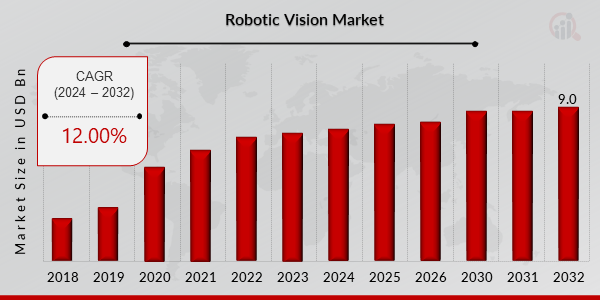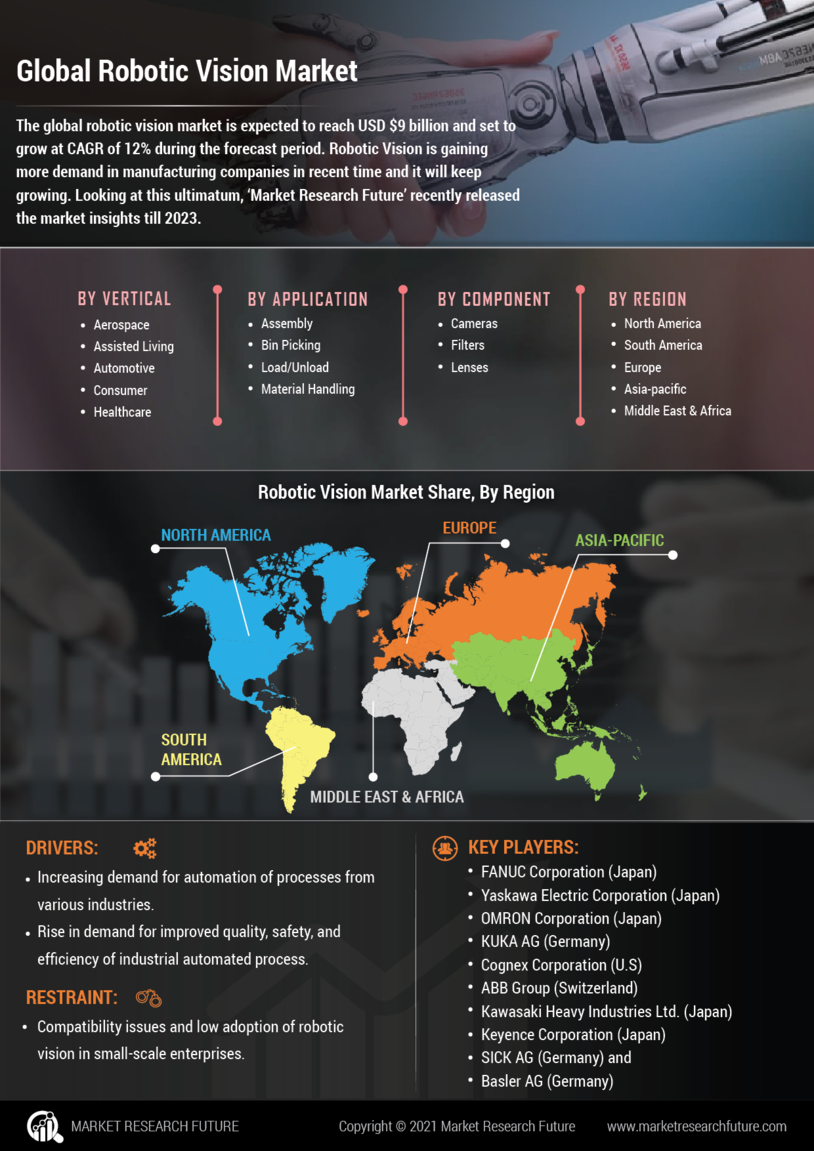Global Robotic Vision Market Overview
The global robotic vision market is estimated to reach a valuation of USD 9 billion at a CAGR of 12% during the forecast period that ends in the year 2032.
Computer vision robotics is the next big thing in the robotic development field that uses computer vision algorithms and machine learning techniques for autonomous robots. The machine learning-based robot eyes use algorithms to identify the objects in the environment and use this data to react accordingly. However, the computer vision-based system relies on sensors for image processing instead of algorithms. The robotic vision market's growth is primarily accounted for by the increased utilization of cognitive humanoid robots and the increased use of machine vision systems in the global automotive industry.
Robotic vision system enables robots to utilize cameras and image processing to supplement or supplant manual inspection jobs. The applications vary from simple tasks, such as detecting the existence of something, to conducting inspections in real time. Leading manufacturing organizations worldwide are increasingly recognizing the advantages of employing robotic vision technologies, especially in areas where repetitive operations, such as inspection, require high levels of accuracy. They have a crucial function in high-speed production lines and dangerous situations. The notable advantages of these systems encompass enhanced efficiency, minimized machine idle time, and enhanced process regulation.

Source: Secondary Research, Primary Research, MRFR Database and Analyst Review
Robotic Vision Market Trends
The introduction of the Industry 4.0 trend is aiding the robotic vision market's growth.
Industry 4.0 refers to the automation and data sharing that is taking place in the field of industrial manufacturing. The industrial manufacturing sector has experienced a rise in the need for automation as a result of the widespread use of advanced technologies such as the Internet of Things (IoT), artificial intelligence (AI), 3D robotic vision and cloud computing. Robotic vision systems are a crucial component of automation and vital for Industry 4.0. Imaging technologies, including 3D machine vision systems, depend on data that is low-latency and uncompressed to make decisions in real-time. Inadequate data quality or delivery might result in expensive production stoppages, additional inspections, or a product recall that can damage the company's reputation. The incorporation of cutting-edge technology into robotic vision systems facilitates the integration of several image and data sources, encompassing the output from 2D, 3D, and 4D sensors. The Internet of Things (IoT) facilitates the integration of artificial intelligence (AI) and machine learning into inspection systems by enhancing vision-guided robotic systems. The utilization of machine vision in the Internet of Things (IoT) entails providing a degree of analysis and conceptualization employed in the process of decision-making or additional automation. Moreover, it aids in broadening the scope of robots' involvement in executing production-line duties, such as selecting, categorizing, and conducting a scan of the manufacturing line. In addition, sensors are getting more sophisticated and can support computer vision algorithms. As a result, the data they produce provides vital information on the operation of industrial systems. This information assists manufacturers in making informed decisions for their business goals.
Robotic Vision Market Segment Insights
The global robotic vision market is primarily segmented based on technology type, component, and end-user.
Based on the Technology Type, the said market segment is further divided into 3D sensors, actuators, and cameras. Out of which, the 3D sensor system is said to dominate the global market share. Companies are increasingly using 3D sensors for varied industrial uses such as inspection, object recognition, and navigation. These sensors generate a 3D point cloud of the environment and provide information about the shape, size, color, texture and distance of objects. A robotic vision system that integrates these into a system is typically referred to as Autonomous Robotic System or ARS.
Based on Component, the robotic vision market is further sub-segmented into Software, Smart Camera and Frame grabbers. Out of which, the software sub-segmentation owns the major market share. The software segment is expected to experience the highest compound annual growth rate (CAGR) throughout the forecast period. The incorporation of artificial intelligence (AI) into robotic process automation software is anticipated to drive the expansion of the robotic vision market because deep learning empowers robots to identify and classify things accurately. Deep learning-powered visual software reduces the need for human involvement and offers a real-time solution by accurately identifying acceptable product variants and defects in manufacturing businesses.
Based on end-user insights, the robotic vision market is further divided into the automobile industry, security services and healthcare sector. Out of these, the healthcare sector dominates the global market share. Robotic surgical systems, including the da Vinci Surgical System, rely heavily on robotic vision. These devices enable minimally invasive procedures to be performed with greater precision and control. The potential for greater precision in healthcare resides in the advancement of robotic vision and the expansion of its application to encompass a broader spectrum of surgical procedures. To obtain high-quality images of the internal structures of a patient, diagnostic instruments such as MRI, CT scanners, and ultrasound machines employ sophisticated vision systems. Market opportunities include enhancing imaging technology, reducing radiation exposure, and improving diagnostic precision.
Robotic Vision Market Region Insights
The global robotic vision market is primarily studied across four major regions, namely North America, Europe, Asia-Pacific and the Rest of the World. Out of which, the North American region is said to dominate the global market share dominating other regions in terms of revenue generation. In 2022, North America held a prominent position in the robotic vision market, accounting for almost 28% of the total market share. The rapid adoption of new and advanced technology and the presence of high discretionary money in the region are the key reasons behind this. In addition to these factors, the growing investments in the advancement of these technologies by corporations and the expanding use of robots in various industries are propelling the regional market. Industrial automation uses such systems to oversee multiple critical functions. In addition, several manufacturers have implemented automation to streamline repetitive tasks.
Followed by North America, the Asia-Pacific region also owns a substantial market share and is stated to exhibit a CAGR of 4.5% during the forecast period, owing to the increasing adoption of machine vision systems for scanning and assessing the quality of goods and products in several industrial applications. Moreover, the Asia-Pacific market's growth is bolstered by heightened government efforts in countries like India, Singapore, and South Korea to encourage foreign direct investment (FDI) in the manufacturing sector.
Europe being the global industrial hub, has a strong manufacturing economy, and as the robotic vision system helps improve production and quality, the said region is said to grow faster than any other region. Robotic vision and control systems inspect and assemble components properly, helping German automakers maintain quality, which is why it has a huge adoption rate and will eventually help the European region to have a significant growth rate during the forecast period.
Robotic Vision Market Key Players & Competitive Insights
Several key companies in the said market segment are now investing in high-end robotic vision technologies to increase the performance of their existing models, develop new models, and integrate with other systems. Some of the renowned key players in the Robotic Vision Market are Google Inc., Dassault Aviation SA, KUKA AG and Cisco Systems Incorporated.
Robotic Vision Market Key Players Insights
Robotic Vision Industry Developments
October 2023 -
In October 2023, Cognex introduced its new product in the smart camera range named 'In-Sight D900', which comes with deep learning capabilities for complex 3D object recognition tasks.
September 2023 -
In September 2023, Cisco, a leading name in the global industry signed an acquisition deal with Splunk organization, to aid in providing a more secure and resilient AI-powered system.
October 2023 -
In October 2023, NVIDIA, a renowned leader in the global market, launched 'ISAAC Sim', a new-age software platform for simulating and testing robotic vision systems in virtual environments.
Robotic Vision Market Segmentation:
Robotic Vision Service Outlook:
- Healthcare
- Security Service
- Automobile Sector
Robotic Vision Technology Outlook:
- 3D sensors
- Autonomous Robotic System
- Actuators
- Cameras
Robotic Vision Region Outlook:
- Europe
- Asia-Pacific
- North America
- Middle East & Africa
- Latin America
| Report Attribute/Metric |
Details |
| Market Size 2032 |
USD 9 Billion |
| Compound Annual Growth Rate (CAGR) |
12% (2024-2032) |
| Base Year |
2023 |
| Forecast Period |
2024-2032 |
| Historical Data |
2018-2022 |
| Market Forecast Units |
Value (USD Billion) |
| Report Coverage |
Revenue Forecast, Competitive Landscape, Growth Factors, and Trends |
| Segments Covered |
Vertical, Application, Component |
| Geographies Covered |
North America, Europe, Asia-Pacific, and Rest of the World (RoW) |
| Countries Covered |
The U.S, Canada, Mexico, Germany, France, UK, China, Japan, India, Australia, South Korea, UAE, and Brazil |
| Key Companies Profiled |
Google Inc, Dassault Aviation SA, KUKA AG, Cisco Systems Incorporated, Alphabet, Microsoft, Intel, IBM, Apple, Bosch, Panasonic |
| Key Market Opportunities |
The biggest reason is their benefits over human-operated cameras |
| Key Market Dynamics |
The automotive industry is expected to see an increase in demand for self-driving vehicles. |
Robotic Vision Market Highlights:
Frequently Asked Questions (FAQ) :
The demand to advance cognitive humanoid robots is estimated to induce favorable growth in the market.
The prominent market leaders are Yaskawa Electric Corporation (Japan), KUKA AG (Germany), FANUC Corporation (Japan), Cognex Corporation (U.S), ABB Group (Switzerland) and OMRON Corporation (Japan),
The region of APAC is expected to show the most promise in the coming period due to the Intensifying implementation of automation in control and quality.
The segments in the global market are technology, components, applications, region, and verticals.
The advancements in machine learning and deep learning for image processing are expected to pull the development of the market.




























